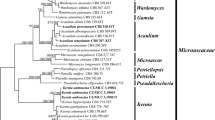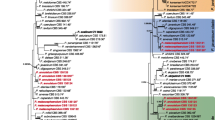Abstract
Penicillium section Charlesia was established based on a multigene phylogeny of P. charlesii, P. coffeae, P. fellutanum, P. georgiense, P. indicum and P. phoeniceum. Since then, three additional species were described in the section. Species can occur on a wide range of substrata including soil, corn, coffee, water, air, deteriorating cloth and clinical samples. The majority of species in section Charlesia grow restricted on Czapek yeast extract agar and produce smooth-walled, vesiculate, monoverticillate conidiophores. A limited number of studies have reviewed the taxonomy of this section. In the present study, available strains belonging to section Charlesia were evaluated in a multilocus phylogenetic analysis using the ITS rDNA region, partial β-tubulin (BenA), calmodulin (CaM) and RNA polymerase II second largest subunit (RPB2) sequences. This analysis revealed 12 distinct species, including three that are newly described here as Penicillium aspericonidium, P. fusiforme and P. longiconidiophorum. The macromorphology on different media, vesicle width, stipe length and ornamentation, and conidial shape and size are important morphological characters for distinguishing species of section Charlesia.






Similar content being viewed by others
Data availability
All available via Amanda Juan Chen amanda_j_chen@163.com.
References
Cole RJ, Dorner JW, Cox RH et al (1981) Isolation of Citreoviridin from Penicillium charlesii cultures and molded pecan fragments. Appl Environ Microbiol 42:677–681
Crous PW, Carnegie AJ, Wingfield MJ et al (2019a) Fungal Planet description sheets: 868–950. Persoonia 42:291–473
Crous PW, Wingfield MJ, Lombard L et al (2019b) Fungal Planet description sheets: 951–1041. Persoonia 43:223–425
Diao YZ, Chen Q, Jiang XZ et al (2018) Penicillium section Lanata-divaricata from acidic soil. Cladistics 35:1–36
Houbraken J, Samson RA (2011) Phylogeny of Penicillium and the segregation of Trichocomaceae into three families. Stud Mycol 70:1–51
Houbraken J, Frisvad JC, Samson RA (2011) Taxonomy of Penicillium section Citrina. Stud Mycol 70:53–138
Houbraken J, Frisvad JC, Seifert KA et al (2012) New penicillin-producing Penicillium species and an overview of section Chrysogena. Persoonia 29:78–100
Houbraken J, Visagie CM, Meijer M et al (2014) A taxonomic and phylogenetic revision of Penicillium section Aspergilloides. Stud Mycol 78:373–451
Houbraken J, Wang L, Lee HB et al (2016) New sections in Penicillium containing novel species producing patulin, pyripyropens or other bioactive compounds. Persoonia 36:299–314
Houbraken J, Kocsubé S, Visagie CM et al (2020) Classification of Aspergillus, Penicillium, Talaromyces and related genera (Eurotiales): an overview of families, genera, subgenera, sections, series and species. Stud Mycol 95:5–169
Katoh K, Rozewicki J, Yamada KD (2019) MAFFT online service: multiple sequence alignment, interactive sequence choice and visualization. Brief Bioinform 20:1160–1166
Klas KR, Kato H, Frisvad JC et al (2018) Structural and stereochemical diversity in prenylated indole alkaloids containing the bicyclo[2.2.2]diazaoctane ring system from marine and terrestrial fungi. Nat Prod Rep. https://doi.org/10.1039/c7np00042a
Kozlov AM, Darriba D, Flouri T et al (2019) RA×ML-NG: a fast, scalable, and user-friendly tool for maximum likelihood phylogenetic inference. Bioinformatics 35:1–3
Peterson SW (2000) Phylogenetic analysis of Penicillium species based on ITS and LSU-rDNA nucleotide sequences. In: Samson RA, Pitt JI (eds) Integration of modern taxonomic methods for Penicillium and Aspergillus classification. Harwood Academic Publishers, Amsterdam, pp 163–178
Peterson SW, Vega FE, Posada F et al (2005) Penicillium coffeae, a new endophytic species isolated from a coffee plant and its phylogenetic relationship to P. fellutanum, P. thiersii and P. brocae based on parsimony analysis of multilocus DNA sequences. Mycologia 97:659–666
Peterson SW, Jurjević Ž, Frisvad JC (2015) Expanding the species and chemical diversity of Penicillium section Cinnamopurpurea. PloS One 10:e0121987
Pitt JI (1980) The genus Penicillium and its teleomorphic states Eupenicillium and Talaromyces. Academic Press, New York
Pitt JI, Samson RA (1993) Species names in current use in the Trichocomaceae (Fungi, Eurotiales). Koeltz Scientific Books, Königstein
Pitt JI, Samson RA, Frisvad JC (2000) List of accepted species and their synonyms in the family Trichocomaceae. In: Samson RA, Pitt JI (eds) Classification of Penicillium and Aspergillus: integration of modern taxonomic methods. Harwood Publishers, Reading, UK, pp 9–50
Posada D, Crandall KA (1998) MODELTEST: testing the model of DNA substitution. Bioinformatics 14:817–818
Raper KB, Thom C (1949) A manual of the penicillia. Baltimore, Maryland, Williams & Wilkins
Rivera KG, Seifert KA (2011) A taxonomic and phylogenetic revision of the Penicillium sclerotiorum complex. Stud Mycol 70:139–158
Ronquist F, Teslenko M, van der Mark P et al (2012) MrBayes 3.2: efficient Bayesian phylogenetic inference and model choice across a large model space. Syst Biol 61:539–542
Taylor JW, Jacobson DJ, Kroken S et al (2000) Phylogenetic species recognition and species concepts in fungi. Fungal Genet Biol 31:21–32
Visagie CM, Houbraken J, Rodriques C et al (2013) Five new Penicillium species in section Sclerotiora: a tribute to the Dutch Royal family. Persoonia 31:42–62
Visagie CM, Houbraken J, Frisvad JC et al (2014) Identification and nomenclature of the genus Penicillium. Stud Mycol 78:343–371
Visagie CM, Houbraken J, Seifert K et al (2015) Four new Penicillium species isolated from the fynbos biome in South Africa, including a multigene phylogeny of section Lanata-Divaricata. Mycol Prog 14:96
Visagie CM, Houbraken J, Dijksterhuis J et al (2016a) A taxonomic review of Penicillium species producing conidiophores with solitary phialides, classified in section Torulomyces. Persoonia 36:134–155
Visagie CM, Renaud JB, Burgess KMN et al (2016b) Fifteen new species of Penicillium. Persoonia 36:247–280
Visagie CM, Seifert K, Houbraken J et al (2016c) A phylogenetic revision of Penicillium sect. Exilicaulis, including nine new species from fynbos in South Africa. IMA Fungus 7:75–117
Wang XC, Chen K, Zeng ZQ et al (2017) Phylogeny and morphological analyses of Penicillium section Sclerotiora (Fungi) lead to the discovery of five new species. 2017, Sci Rep, 7:8233
Wicklow DT (1984) A citreoviridin-producing fungus, NRRL 13013, from pecan fragments is not Penicillium charlesii. 1984. Mycologia 76:943–944
Funding
This research was funded by the Open Funding Project of the State Key Laboratory of Bioactive Substance and Function of Natural Medicines No. GTZK201903.
Author information
Authors and Affiliations
Contributions
Conceptualization, JH and AJC; methodology, BDS and CMV; formal analysis, BDS and AJC; investigation, BDS; resources, JH and CMV; original draft preparation, BDS and AJC; review and editing, CMV and JH; supervision, JH; funding acquisition, BDS. All authors have read and agreed to the published version of the manuscript.
Corresponding authors
Ethics declarations
Conflict of interest
The authors declare no competing interests.
Additional information
Section editor: Roland Kirschner
Publisher’s note
Springer Nature remains neutral with regard to jurisdictional claims in published maps and institutional affiliations.
Supplementary Information
Below is the link to the electronic supplementary material.
Rights and permissions
About this article
Cite this article
Sun, BD., Visagie, C.M., Chen, A.J. et al. A taxonomic review of Penicillium section Charlesia. Mycol Progress 20, 1383–1397 (2021). https://doi.org/10.1007/s11557-021-01735-3
Received:
Revised:
Accepted:
Published:
Issue Date:
DOI: https://doi.org/10.1007/s11557-021-01735-3




